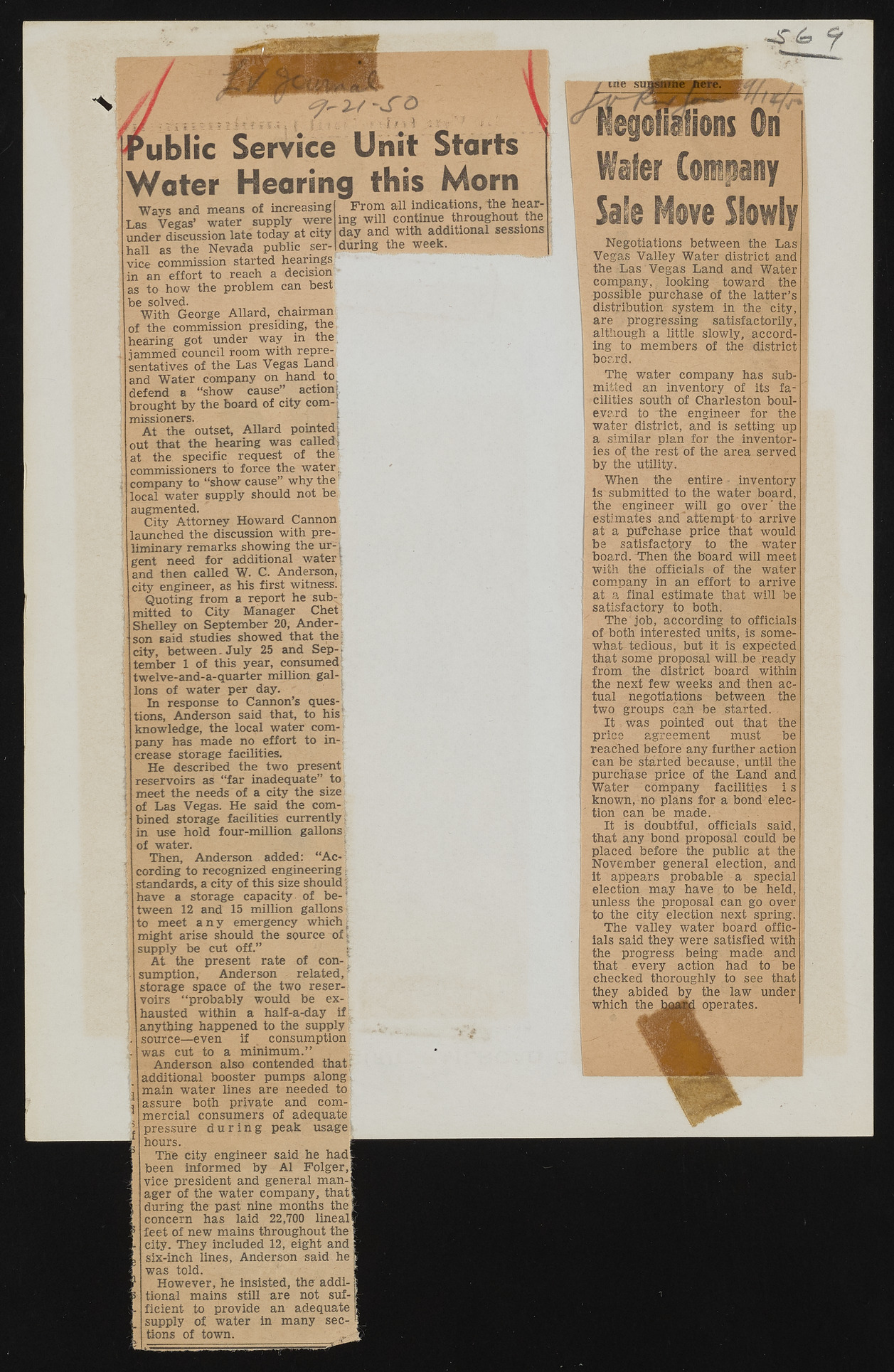Copyright & Fair-use Agreement
UNLV Special Collections provides copies of materials to facilitate private study, scholarship, or research. Material not in the public domain may be used according to fair use of copyrighted materials as defined by copyright law. Please cite us.
Please note that UNLV may not own the copyright to these materials and cannot provide permission to publish or distribute materials when UNLV is not the copyright holder. The user is solely responsible for determining the copyright status of materials and obtaining permission to use material from the copyright holder and for determining whether any permissions relating to any other rights are necessary for the intended use, and for obtaining all required permissions beyond that allowed by fair use.
Read more about our reproduction and use policy.
I agree.Information
Digital ID
Permalink
Details
Member of
More Info
Rights
Digital Provenance
Publisher
Transcription
/ / ________ __ . * ublic Service Unit Starts Water Hearing this Ways and means of increasing Las Vegas’ water supply were under discussion late today at city hall as the Nevada public service commission started hearings in an effort to reach a decision as to how the problem can best be solved. With George Allard, chairman of the commission presiding, the hearing got under way in the jammed council room with representatives of the Las Vegas Land and Water company on hand_ to defend a “show cause” action-, brought by the board of city com-, missioners. J At the outset, Allard pointed; out that the hearing was called; at the specific request of the commissioners to force the water; company to “show cause” why the local water supply should not be augmented. City Attorney Howard Cannon launched the discussion with preliminary remarks showing the ur- J gent need for additional water t and then called W. C. Anderson, city engineer, as his first witness. Quoting from a report he sub-' mitted to City Manager Chet Shelley on September 20, Ander-: son said studies showed that the; city, between. July 25 and Sep-, tember 1 of this year, consumed twelve-and-a-quarter million gallons of water per day. In response to Cannon’s questions, Anderson said that, to his1 knowledge, the local water company has made no effort to in-, crease storage facilities. He described the two present reservoirs as “far inadequate” to meet the needs of a city the size of Las Vegas. He said the combined storage facilities currently in use hold four-million gallons of water. Then, Anderson added: “According to recognized engineering, standards, a city of this size should'; have a storage capacity of be-’ tween 12 and 15 million gallons to meet a n y emergency which t might arise should the source olt supply be cut off.” ; At the present rate of con-' sumption, Anderson related,' storage space of the two reservoirs “probably would be exhausted within a half-a-day if anything happened to the supply source—even if . consumption was cut to a minimum.” Anderson also contended that-additional booster pumps along main water lines are needed to assure both private and commercial consumers of adequate pressure d u r i n g peak usage hours. The city engineer said he had been informed by A1 Folger, vice president and general manager of the water company, that during the past nine months the concern has laid 22,700 lineal feet of new mains throughout the city. They included 12, eight and six-inch lines, Anderson said h e| was told. However, he insisted, the addi- j tional mains still are not suf-' ficient to provide an adequate supply of water in many sec tions of town. From all indications, the hearing will continue throughout the day and with additional sessions during the week. / me suj mm f / IS Negotiations between the Las Vegas Valley Water district and the Las Vegas Land and Water company, looking toward the possible purchase of the latter’s distribution system in the'city, are progressing satisfactorily, although a little slowly, according to members of the district board. Thq water company has submitted an inventory of its fa-' cilities south of Charleston boulevard to the engineer for the water district, and is setting up a similar plan for the inventories o£ the rest Of the area served by the utility. When the entire • inventory is submitted to the water board, the engineer will go over ’ the estim ates. and 'attempt • to arrive at a purchase price that would be satisfactory to the water board. -Then the board will meet with the officials of the water company in an effort to arrive at a final estimate that will be satisfactory to both. The job, according to officials of both interested units, is somewhat tedious, but it is expected that some proposal will be ready from the district board within the next few weeks and then actual negotiations between the two groups can be started.. It > was pointed out that the price agreement must be reached before any further action can be started because, until the purchase price of the Land and Water company facilities i s known, no plans for a bond election can be made. It is doubtful, officials said, that any bond proposal could be placed before the public at the November general election, and it appears probable’ a special election may have to be held, unless the proposal can go over to the city election next spring. The valley water board officials said they were satisfied with the progress being made and that every action had to be checked thoroughly to see that they abided by the law under which the jaaggid operates.

